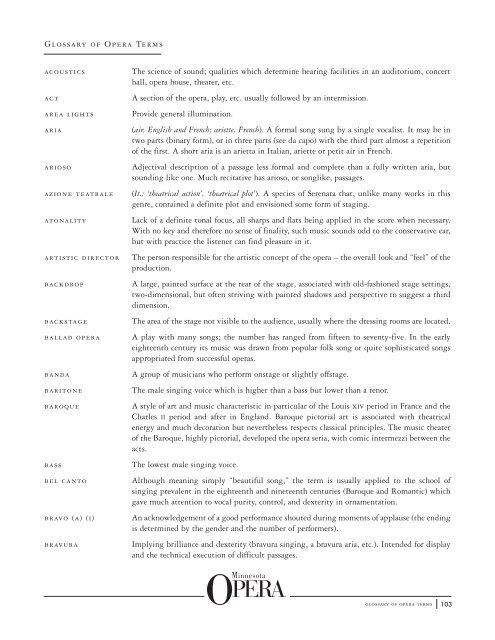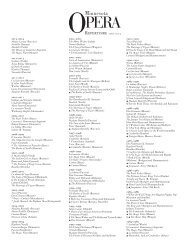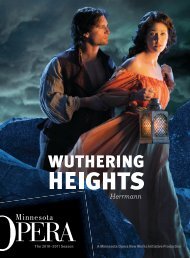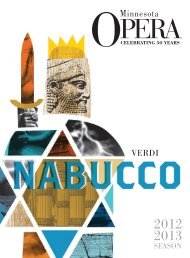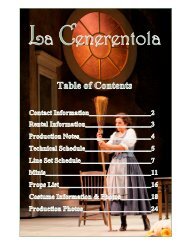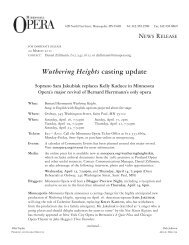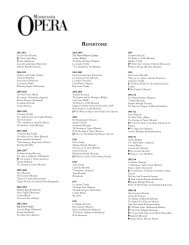Create successful ePaper yourself
Turn your PDF publications into a flip-book with our unique Google optimized e-Paper software.
Glossary of <strong>Opera</strong> Terms<br />
acoustics<br />
act<br />
area lights<br />
aria<br />
arioso<br />
azione teatrale<br />
atonality<br />
artistic director<br />
backdrop<br />
backstage<br />
ballad opera<br />
banda<br />
baritone<br />
baroque<br />
bass<br />
bel canto<br />
bravo (a) (i)<br />
bravura<br />
The science of sound; qualities which determine hearing facilities in an auditorium, concert<br />
hall, opera house, theater, etc.<br />
A section of the opera, play, etc. usually followed by an intermission.<br />
Provide general illumination.<br />
(air, English and French; ariette, French). A formal song sung by a single vocalist. It may be in<br />
two parts (binary form), or in three parts (see da capo) with the third part almost a repetition<br />
of the first. A short aria is an arietta in Italian, ariette or petit air in French.<br />
Adjectival description of a passage less formal and complete than a fully written aria, but<br />
sounding like one. Much recitative has arioso, or songlike, passages.<br />
(It.: ‘theatrical action’, ‘theatrical plot’). A species of Serenata that, unlike many works in this<br />
genre, contained a definite plot and envisioned some form of staging.<br />
Lack of a definite tonal focus, all sharps and flats being applied in the score when necessary.<br />
With no key and therefore no sense of finality, such music sounds odd to the conservative ear,<br />
but with practice the listener can find pleasure in it.<br />
The person responsible for the artistic concept of the opera – the overall look and “feel” of the<br />
production.<br />
A large, painted surface at the rear of the stage, associated with old-fashioned stage settings,<br />
two-dimensional, but often striving with painted shadows and perspective to suggest a third<br />
dimension.<br />
The area of the stage not visible to the audience, usually where the dressing rooms are located.<br />
A play with many songs; the number has ranged from fifteen to seventy-five. In the early<br />
eighteenth century its music was drawn from popular folk song or quite sophisticated songs<br />
appropriated from successful operas.<br />
A group of musicians who perform onstage or slightly offstage.<br />
The male singing voice which is higher than a bass but lower than a tenor.<br />
A style of art and music characteristic in particular of the Louis xiv period in France and the<br />
Charles II period and after in England. Baroque pictorial art is associated with theatrical<br />
energy and much decoration but nevertheless respects classical principles. The music theater<br />
of the Baroque, highly pictorial, developed the opera seria, with comic intermezzi between the<br />
acts.<br />
The lowest male singing voice.<br />
Although meaning simply “beautiful song,” the term is usually applied to the school of<br />
singing prevalent in the eighteenth and nineteenth centuries (Baroque and Romantic) which<br />
gave much attention to vocal purity, control, and dexterity in ornamentation.<br />
An acknowledgement of a good performance shouted during moments of applause (the ending<br />
is determined by the gender and the number of performers).<br />
Implying brilliance and dexterity (bravura singing, a bravura aria, etc.). Intended for display<br />
and the technical execution of difficult passages.<br />
glossary of opera terms 103


